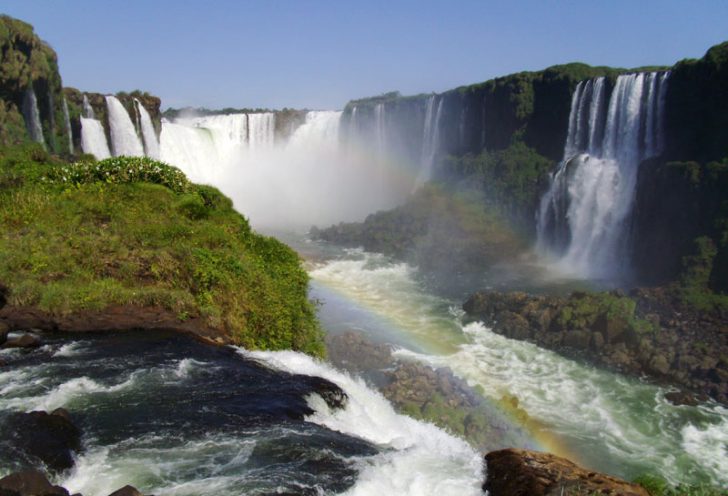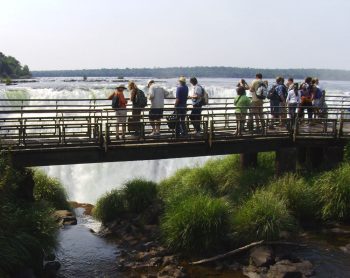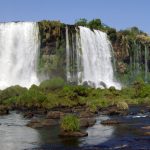
Iguazú (also known as Iguassu or Iguaçu) is the largest system of waterfalls in the world. It is a UNESCO World Heritage site and was voted one of the Seven Natural Wonders of the World. With 275 individual drops, the Iguazú Falls and national parks are located on the Iguazú river, on the border between Argentina and Brazil.
Because the system is so large and it is divided between the two countries, many travelers find themselves wondering about the logistics of how to make the most of a trip to Iguazú Falls. Below I go over the similarities and differences between the Brazilian and Argentinian sides, including how to get there, when to go, and I highlight a few trip itineraries that pair well with an Iguazú Falls adventure.
Which Side of Iguazú Falls Should I Visit?


Both sides include:
- Incredible views of the falls
- Activities around the falls (including zodiac rides, hiking, biking, rappelling, and more)
- Opportunities for natural and cultural excursions
- Hotels within the National Park
So how do I choose between the two? The biggest differences between the Brazilian and Argentian side are in accessing the falls, the views, the walkways and the activities.
Getting To Iguazu Falls Please note that a valid passport and visa are required for US Citizens to travel to Brazil. You can apply for an e-visa to travel to Brazil (for 90-day visits or under) online at this website: http://www.vfsglobal.com/brazil-evisa/. Please note that the e-visa costs $40.00 USD and can take around 10 days to process. We recommend applying for this visa as soon as your trip is confirmed.
The Views At The Falls This is absolutely the most difficult question- which side of the falls is “better?” The answer is always going to be personal. I loved the Brazil side, because I could see the awesome scope of the falls. To me, standing at the top of the Garganta del Diablo (Devil’s Throat) on the Argentine side was impressive, but I couldn’t see much through the mist that day. Also, being short on time, we didn’t get to experience any of the other pathways or viewpoints.
Approximately 80% of the waterfalls are on the Argentinian side of Iguazú, so in general from the Brazilian side, you see the falls and on the Argentinian side you feel the falls. It’s the difference between a panoramic photograph and a close-up.
Walkways The format of the Brazilian side of Iguazú is very straightforward: one short walkway that takes you to a few viewing platforms. All visitors must follow this single path and there is no variation.
On the Argentinian side there is a web of pathways leading to different areas and views of the park and falls, allowing space to get off the beaten track and get a variety of perspectives on this wonder of nature.
Helicopter Ride The only way to see the falls via helicopter is on the Brazilian side. It is a short tour at only 10-15 minutes, but an incredible opportunity to see the full scope of the falls.
How Can I Make It Part of My Trip to South America? How Do I Get To Iguazú Falls?

Many people believe that a trip to Iguazú can be an easy stop from anywhere in South America. In reality, it’s not quickly accessible from everywhere. All flights in and out of Iguazú originate in either Brazil (through São Paolo and arriving in the town of Foz de Iguassu) or Argentina (through Buenos Aires and arriving in Puerto Iguazú). Direct flights from these cities take 1.5 to 2 hours.
Naturally, a stop at Iguazú is a great addition to any trip to Argentina or Brazil, either as an extension before or after a visit to either, or as a means of connecting visits to both countries.
I like to combine Iguazú Falls with a visit to Patagonia. This combination really highlights the beauty and extremes of Argentina, from the cool, mountain peaks in the south to the tropical forest and wildlife of the north. For example, it would be a great extension on the front end of our Argentina & Chile Adventure Trip.
Some of our travelers have also chosen to combine Iguazú with an Active Argentina Itinerary, and it also pairs nicely with a northern and central Argentina experience, including the premiere wine region of Mendoza.
When Should I Visit Iguazú Falls + What Is The Weather Like?

Iguazú has a humid subtropical climate, similar to the southeastern United States.
Summer, which lasts from October until March, is when the water levels of the river and falls are at their highest due to heavy precipitation in October. Many people choose to visit at this time, as higher water levels make the waterfalls particularly spectacular. Additionally, the hottest months of January and February also coincide with local holidays, which means the national parks will have more people.
Dry season occurs in the winter (April to September), when temperatures average in 70s (˚F). While water levels are lower at this time, they are never “low” (barring a drought in the region), and there are fewer tourists.
While you can visit at any time, if you are flexible I recommend going outside of January and February, as the hot, humid weather and high visitor traffic can make the experience less enjoyable.
How Long Should I Stay In Iguazú?

This is the part of the story where your personal preferences will play the largest role. If your time is short, any time spent at the falls will be well worth the trip. However, a stop at Iguazú can take a number of days if you wish to see and do all that this incredible region has to offer.
Most large tour groups spend one night at Iguazú, with a flight in and visit to one side, followed by a stop at the other side the next day. While this type of visit allows you to see the highlights, it is the absolute minimum you would want to spend in such a beautiful place.
In my personal experience this was not enough time to experience everything the national parks have to offer. While I had enough time on the Brazil side of the falls, on the Argentine side I was only able to take the trail that stops at the Garganta del Diablo and had no idea how extensive the trail system is. Had I been on a smaller, more personalized trip, I could have spent more time exploring the parks, sights, and activities the region has to offer.
If you really would like to make the most of your stay and see and do everything, I recommend about three days in the area. The Brazilian side of the falls takes about a half day, but there are also excellent opportunities not available on the other side; get up close and personal with the wildlife at this particularly special park, take a short helicopter ride over the falls, or visit the Itaipu Dam, the second largest power station in the world.
The majority of the trails that lead to different parts of the falls are on the Argentinian side. To follow just the three primary trails would take about a full day of activity.
Both sides also offer the opportunity to take a zodiac ride under the falls, learn about the natural habitat of the region, visit a local Guaraní community, and participate in active and adventurous activities such as zip lining and rappelling. If you are only visiting for a day, it is difficult to see all the highlights, let alone fully experience the region. Also, unpredictable weather could potentially ruin your trip if you only have one chance at seeing the falls.
What About Paraguay?
Many guides to the region mention that Iguazú is situated at the border with Argentina, Brazil, and Paraguay. The Iguazú River does merge with the Paraná River at the Triple Frontier (a triple border between Argentina, Brazil, and Paraguay), but this is after the waterfalls.
You can visit the Itaipu Dam from the Paraguayan side of the river, but there are a number of factors that make this border crossing less popular. The biggest impediment to a Paraguay crossing is the visa requirement for U.S. citizens, which must be obtained in advance if you are entering by land and will cost you $160 USD. In addition to lacking the spectacular falls views of the other two countries, the Paraguayan border town of Ciudad del Este is not as tourist-friendly and does not offer the activities and amenities available in its Brazilian and Argentinian counterparts.
What Else Should I Know About Iguazú Falls?


Protect yourself: Iguazú has a subtropical climate, and therefore mosquitos can be abundant. Make sure you protect yourself by bringing insect repellent with 25% Deet or 20% Picardin.
Coatis: These seemingly cute raccoon-like animals may look adorable, but they are scavengers and will have no problem coming after your food. There are warning signs posted around the park, but visitors who do not heed these warnings can be bitten. Don’t try to approach them to pet or feed them.
Feel the heat: It can get very hot and sunny around the falls. Make sure you have sun protection, including sunscreen (at least 30 SPF) and a hat, and that you carry plenty of water. Many people also forget to protect their lips from the sun, so don’t forget to bring lip balm with SPF protection.
Are you interested in traveling to Iguazú? For more information and pricing on a South America or Iguazú trip, simply give us a call 612-315-2894. You’re likely to get company owners Tara or Jordan Harvey on the phone, and we’re happy to chat travel at absolutely no obligation to you. Or send us a quick email at [email protected] and we’ll get back to you shortly.
 Krista is part of the Operations team at Knowmad Adventures, a company dedicated to creating unique, private and custom trips in South America. She has lived in six countries on four continents and visited more than fifty countries, but is now settled back in her home state of Minnesota where she loves sharing her passion and knowledge with fellow travelers.
Krista is part of the Operations team at Knowmad Adventures, a company dedicated to creating unique, private and custom trips in South America. She has lived in six countries on four continents and visited more than fifty countries, but is now settled back in her home state of Minnesota where she loves sharing her passion and knowledge with fellow travelers.































